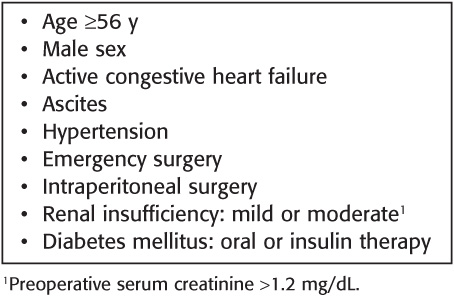General Surgery Acute Kidney Injury Risk Index
Risk Factors

General Surgery Acute Kidney Injury Risk Index classes based on number of risk factors present: class I (0–2 risk factors), class II (3 risk factors), class III (4 risk factors), class IV (5 risk factors), and class V (≥6 risk factors).
From Kheterpal S, Tremper KK, Heung M, et al. Development and validation of an acute kidney injury risk index for patients undergoing general surgery. Results from a national data set. Anesthesiology 2009;110:505–514. With permission.
Evaluating Renal Function
A. Evaluating renal function: Abnormalities of glomerular function cause the greatest derangements and are used commonly for renal assessment. Blood urea nitrogen (BUN) is directly related to protein catabolism and inversely related to glomerular filtration. Therefore, BUN is only reliable if protein catabolism is normal and constant. Creatinine production is fairly constant and related to muscle mass. It is filtered but not reabsorbed in the kidneys. Creatinine is generally reliable indices of glomerular filtration rate but may become inaccurate in the setting of critical illness.
B. BUN/creatinine ratio: Ratios greater than 15:1 are seen in volume depletion and disorders of decreased tubular flow (e.g., congestive heart failure, cirrhosis, nephrotic syndrome).
C. Creatinine clearance: The most accurate method for overall kidney function.
![]()
D. Urinalysis: pH, specific gravity, glucose, bilirubin content, and urinary sediment can help detect certain renal dysfunction.
Altered Renal Function and the Effects of Anesthetic Agents
• Propofol and etomidate: No significant effect
• Barbiturates: Patients with renal disease may display increased sensitivity.
• Ketamine: No significant effect
• Benzodiazepines: Diazepam and midazolam should be administered cautiously in the presence of renal impairment because of accumulation of active metabolites.
• Opioids: The accumulation of morphine (morphine-6-glucuronide) and meperidine (normeperidine) metabolites may prolong respiratory depression in the presence of renal failure, and normeperidine may cause seizures.
• Anticholinergic agents: The central nervous system effects of scopolamine can be enhanced by the physiologic alterations of renal insufficiency.
• Succinylcholine: Used safely in kidney failure if serum potassium concentration is less than 5 mEq/L
• Cisatracurium: Degraded by Hoffman elimination; therefore, a very beneficial nondepolarizing agent in patients with kidney failure
• Vecuronium and rocuronium: Primarily hepatic but up to 20% eliminated in urine
• Pancuronium, pipecuronium, doxacurium: Primary dependent on renal elimination. Neuromuscular function needs to be closely monitored in the setting of renal dysfunction.

Full access? Get Clinical Tree





